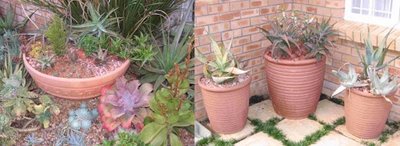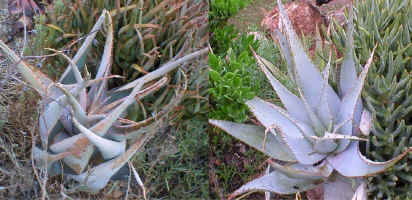
Photo above right is a Protea species.
This is the habitat of Aloe haemanthifolia one of the rarest aloes - This aloe grows high up in the mountains mostly in crevices of cliffs which gives it the necessary protection against anybody who would like one for some reason.
The trip was the oposite direction from our usual succulent country into the mountains with fynbos vegetation. I do not mind walking on a mountain but driving at speed (any speed faster than a walk) round corners on a wet misty road at a dizzy hight, is not my cup of tea. Rudi had to stop at the look-out spots so that I could unclench my fists and breathe.
A misty morning did not make for the best photo. The proteas were gorgeous. There were many small types and also the well known large pink one.
The rain filtering through the fallen leaves on the ground color the water like tea but I would not advise anybody to drink it! There are many different leaves in that tea and the water is very acid which is what most proteas like.

I would not expect an aloe here anywhere near. Although I know that Aloe plicatilis grows just around the mountain more to the west in the Cape Town area. Aloe plicatilis likes slightly acid to neutral soil and does very well in winter rainfall gardens.
Photo right:
This photo does not give the real impression what this aloe looks like. The thin stiff leaves are large. A foot long (30cm). I would have passed this plant thinking it is a lily of sorts. (The flowers would give it away. )
Good news for the colder wet countries. e.g. Canada, UK and Europe. This aloe is for you !
Photo above left:
Aloe plicatilis is a tree aloe with fans instead of the usual rosettes. It would seem that Aloe haemanthifolia is a large fan without the trunk. Aloe plicatilis grows much lower down than Aloe haemanthifolia and in a larger warmer habitat. Aloe plicatilis does not mind water but unlike Aloe haemanthifolia it grows in a frost free area.




